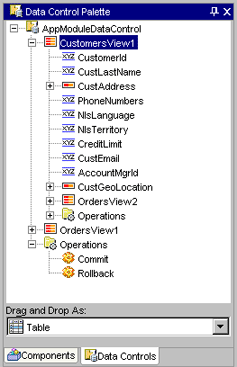
 


|
|
|
|
Data Binding
| Oracle ADF provides a consistent drag-and-drop
data binding experience for many different server-side technologies,
including ADF Business Components, TopLink, EJBs, web services,
and Plain Old Java Objects (POJOs). |
|

|
|
Client developers use the Data Control Palette to create databound
HTML elements (for JSP pages), Oracle ADF UIX elements (for UIX
XML pages), and Swing UI components (for JClient panels).
In addition, developers who use TopLink as the persistence architecture
for their custom Java classes can leverage the common data binding
features in the ADF Model layer to simplify building JSP, UIX
XML, and Swing application user interfaces.
|
|
Visually, the palette comprises two parts:
- The top portion of the window, which displays available business
services. The list represents model objects, including data
collections, attributes, and actions that the business services
developer exposed to the client application through a data control
definition file.
- The bottom portion of the window, which displays a dropdown
list of UI components. The list represents binding types suitable
for the current business service selection.
|
|

